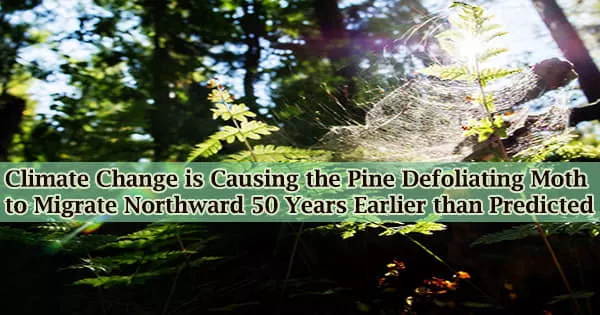Climate change is forcing the pine pest Panolis flammea, sometimes known as the pine beauty moth, to shift its range northward 50 years earlier than expected in Finland. According to a new study from the University of Eastern Finland, changes in the range and size of the pine beauty moth population are linked to rising temperatures. Scandinavian Journal of Forest Research published the findings.
“This is not unexpected, since many scientists have previously predicted that some insect pests will shift their distribution range northward as a result of rising temperatures caused by climate change. However, what is astonishing is that this is happening 50 years ahead of earlier predictions,” Doctoral Researcher Alexander Pulgarin Diaz from the University of Eastern Finland says.
The pine beauty moth larvae feed on the needles of several pine species throughout Central Europe, causing occasional outbreaks that are generally managed with chemical insecticides. These outbreaks occur in conjunction with other pine insect pests and illnesses, and they have the potential to spread over thousands of hectares.
Although no outbreaks have been observed in Finland, conditions for their spread may improve as a result of rising temperatures and declining forest health, both of which are results of climate change.
This is not unexpected, since many scientists have previously predicted that some insect pests will shift their distribution range northward as a result of rising temperatures caused by climate change. However, what is astonishing is that this is happening 50 years ahead of earlier predictions.
Alexander Pulgarin Diaz
Temperature has been linked to the development and dispersal of insects in previous research. The researchers combined the number of collected individuals with the previous year’s thermal summation for the same region to analyze the distribution and size of the pine beauty moth population in Finland.
They utilized traps all around Finland to do so, and discovered that the insect problem had moved as far north as 68°51’N. They also discovered that it was more abundant in warmer climates, such as southern Finland.
As climate change progresses and temperatures rise in Finland, the pine beauty moth’s range and population density may expand, allowing it to become a common and prolific pine-feeder across the country.
The findings of this study on the pine beauty moth are consistent with those of a previous study on another prominent pine defoliator, the Nun moth (Lymantria monacha), which has also increased dramatically in Finland since 2000.
The study was funded by the Academy of Finland Flagship Programme Forest-Human-Machine Interplay Building Resilience, Redefining Value Networks and Enabling Meaningful Experiences (UNITE) (decision no: 337127).
















